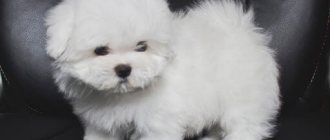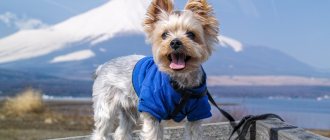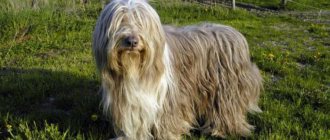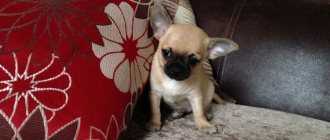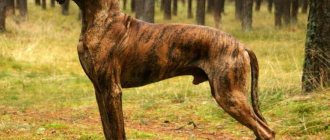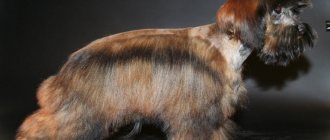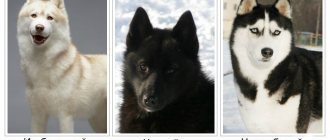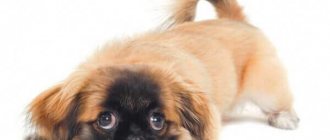| Origin: | Central Mediterranean |
| Usage: | companion, decorative dog |
| Color: | white |
| Dimensions: | 3-4 kg, 20-25 cm |
| Lifespan: | 12-15 years |
The Maltese is the oldest decorative dog. For her snow-white, flowing coat, her kindness and easy-going disposition, she is often called an angel. From ancient times to today, having a puppy of this breed is a sign of luxury and belonging to a noble class.
Exterior
The breed standard of the Fédération Cynologique Internationale (FCI) classifies the Maltese as a group of toy dogs, a subgroup of the Bichon and related breeds. In addition to the Maltese, this also includes Bolognese and Bichon Frize.
Photo of an adult Maltese dog.
Maltese dogs look charming, both in person and in photographs. These are miniature dogs with a snow-white coat that flows down the sides, black beady eyes and a charcoal nose. They have smooth, refined movements and the manners of aristocrats.
The table provides a detailed description of the breed.
| Parameter | Breed standard |
| Height | 21-25 cm males, 20-23 cm females. |
| Weight | 3-4 kg. |
| Constitution | Developed, dry, without roughness. |
| Frame | Stretched out, with a long straight back and a short arched loin. The neck is of moderate length and holds the head elegantly. The chest is voluminous, long, in circumference equal to 2/3 of the dog’s height. The stomach is slightly retracted. |
| Head | The length reaches more than half the height at the withers. Proportional, wide, ovoid, with a convex crown and nape. The forehead is divided in the middle by a hollow. |
| Ears | They stand high, hanging, if the dog is alert, they rise. In the shape of a triangle with round ends. Covered with long hair, which smoothly connects with the fur coat at the withers. |
| Eyes | Large, round in shape, set low and moderately deep. The color is dark brown, the edging is black. |
| Nose | Small, black. |
| Lips | Dry, thin, black mucous. The upper lip hangs over the lower lip. |
| Bite | Scissor-shaped. |
| Limbs | Straight, muscular, parallel when viewed from the rear or front. Stand clearly under the body, elbows pressed to the chest. |
| Paws | Small, collected in a round lump. Richly covered with wool. The pads and claws are strong and black. |
| Tail | Stands at the height of the back, thrown back and pressed to the body on the left or right. Equal to 60% of the dog's height, trimmed with straight, flowing hair. |
| Wool | Straight, long, reaches 22 cm, spreads along the ground. There is no undercoat. A mantle flows down the sides. The hairs on the head are the longest, blending in with the hair on the ears and face. |
| Color | White, less often - ivory. |
There are mini (toy) representatives weighing up to 2 kg. But they are not recognized by FCI, AKC and RKF.
Description of the breed
The Maltese dog has a proportionally developed body, and its movements are smooth. The weight of an adult dog is no more than 4 kg. Boys are several centimeters taller than girls. The size of an adult dog is 20-25 cm, which makes the animal very compact.
- The skull is flat, larger in size than the muzzle. The forehead is clearly defined. The ears are triangular in shape, set high, and fit tightly to the head.
- The nose is small, the earlobe is black and large. The jaws are developed and small. They do not protrude beyond the muzzle, the lips are thin, and the bite is scissor-shaped.
- The eyes are round, the color of the iris is dark brown. The breed standard does not include deep-set or protruding eyes.
- The neck stands out, is covered with thick hair, there are no folds. The back is straight, the chest is deep.
- The tail is set high. It is thicker at the base and thins towards the end. The shape is arched, slight deviation to the side is acceptable.
- The front legs are located close to the body. The limbs are not muscular, but the bones are strong. The fingers are pressed tightly together, the pads are painted black.
Dogs' fur is long and dense, soft to the touch. There are no curls or curls. The limbs may be slightly shaggy. The standard color of the Maltese is white, but pale orange or ivory is acceptable. But such tones can give the coat a gray, dirty look and are therefore considered undesirable.
There is an American subtype of the breed, which is considered its mini version (weight from 2.7 kg, does not exceed 3.2 kg). The coat of such animals is somewhat shorter, but it cannot be said that this dwarf dog is short-haired.
Character
The external characteristics of the Maltese completely coincide with its character. A dog that appears funny and cute is friendly, active, and affectionate. The pet is devoted to all family members; its docile nature makes the Maltese accessible to an inexperienced dog breeder.
Even despite its fragile appearance, the Maltese will always rush to protect its owners in moments of danger. Moreover, it doesn’t matter to her who the potential threat is: an animal or a person. The dog usually warns of its intentions by barking loudly, but may also use its teeth. This behavior proves that even small pets can be brave when it comes to keeping their owners safe.
Maltese has an extraordinary intelligence, thanks to which he can easily master not only basic commands, but also complex tricks. However, some of them can be quite stubborn due to the fact that their owners spoil them too much.
It is better not to have miniature dogs in families with small children, as they can accidentally injure the animal during play. But lap dogs will get along well with an older child.
The Maltese has a friendly disposition towards other animals. It will not harm cats or rodents. The animal is very attached to its owners, so it is not worth leaving it for a long time. Otherwise, the dog will begin to worry, which will lead to severe stress.
Pros and cons of character
Malteses are the embodiment of love and tenderness. The highest happiness for them is to be close to their owner. And it doesn’t matter what a person is doing: playing, resting, working or cooking. Maltese dogs happily participate in any activity.
The Maltese not only has an angelic appearance, but also an angelic character. They are not prone to irritability, mood swings or grumpiness like other decorative breeds. Dogs pick up on people's moods and adapt to them.
Some Maltese dogs are moody. But this is the result of poor upbringing: overprotection and indulgence in whims.
Reviews from owners say that dogs catch thoughts. They understand when the owner is upset and predict what he is going to do.
Maltese love all family members and do not single out any one person. The disadvantages of the Maltese dog are that they are attached to people and cannot stand being alone. Sometimes this trait is developed to the point of neurosis: as soon as the pets are left alone, they begin to howl, whine and destroy the apartment. You cannot leave your pets alone for more than an hour.
Maltese dogs are playful and active. They delight in their “attacks of energy”: a couple of times a day, the dogs suddenly start rushing around or running in circles.
At the same time, Maltese dogs are not hardy. After wandering around for 5-15 minutes, they calm down and go to lie down on their favorite ottoman.
The Maltese has a weak nervous system. They are handled with care. Irritability and rudeness are unacceptable.
True friend
The authority of the owner for the Maltese dog is absolute and unquestioning. A dog constantly expresses its devotion and love to a person. Having played enough, the Maltese will definitely come to rest next to its owner in order to be in the company of people for as long as possible.
Loneliness is destructive for this breed. Left alone in an empty room, the dog will bark and whine loudly - this is how it demonstrates its suffering. This feature of the Maltese should be taken into account when choosing a pet breed. It is better that there is always someone in the house where the puppy will live. If you leave a dog locked up all day, it will not only become upset, but will also drive the neighbors crazy with its barking.
The character of the Maltese dog is gullible and sociable. To make friends with a puppy, you need to show attention to it and caress it - the Maltese adore it, and therefore will gladly reciprocate. Dogs of this breed give their endless supply of tenderness and love to all family members, but most of all goes to the owner and children.
The Maltese's love for children is always mutual. Well, how can a child not like a faithful companion, a reliable friend and a good companion for any games, and even with an angelic appearance?
Maltese dogs subtly sense the mood of their household. Dogs are always able to adapt to the rhythm of life of their owners, showing restraint or activity.
Application
From the first day of its existence until today, Maltese dogs are exclusively companions. They were created to love and be loved.
At the same time, the Maltese breed demonstrates good watchdog and security qualities. Despite its tiny size, in case of danger the dog fiercely defends itself and its owner. True, not all pets have this trait.
It is worth considering that a small Maltese dog will not cope with protection. She can only bark or claw at an ill-wisher.
Moreover, pets sound the alarm for any reason. An unpleasant-smelling man passed nearby, the doorbell rang, they were shouting behind the wall, someone was climbing the stairs - and the Maltese immediately gave a voice. The dog should be weaned from excessive barking, otherwise complaints and complaints from neighbors will flow in a torrent.
A decorative dog is best suited for housewives, married couples, elderly people and all those who can and are willing to devote almost all their time to their pets.
Brave Defender
Despite its tiny size, the Maltese cannot be called cowardly. She is capable of zealously protecting her owner, demonstrating fearlessness and courage. As soon as a loved one is in danger, a brave dog will come to his defense. Of course, the dog won’t be able to cause much harm, but its barking will scare you enough.
At the same time, Maltese are distinguished by their balance, and therefore do not cause much trouble. If the owner shows gentleness, kindness and responsiveness towards the pet, the dog will definitely reciprocate.
Socialization
The main characteristic of the breed is the absence of anger. The Maltese is equally good with adults, children and pets.
This does not mean that the Maltese loves everyone. The most important thing for a dog is family. She perceives strangers and guests warily, with interest, but without aggression. The pet only allows family friends to play with him.
Dogs love children immensely and will never hurt them. You need to worry not about the kids, but about the Maltese - the latter often suffers at the hands of restless dogs.
Families with children under 10 years old are not recommended to have animals. Delicate and fragile Maltese dogs must be handled with care. Extremely careful. Even just by squeezing or dropping the dog, the baby will injure him.
Maltese dogs live in perfect harmony with other pets. Whether it’s a St. Bernard, a cat, a hamster or a parrot, the dog is non-confrontational and is friends with everyone.
Upbringing
The characteristics of the breed are such that in the classical sense, training a Maltese is not necessary. However, education, good manners and knowledge of basic commands are necessary.
They begin to work with the animal as soon as the Maltese puppy crosses the threshold of the apartment. The new family member is shown a place, a toilet, given a “tour” of the rooms, and introduced to the household.
Maltese dogs are smart. They understand on the fly what is wanted from them and what behavior is undesirable. The owners note that the dogs go to a diaper or in a basin within 2-3 days, and stop mischievousness after the first reprimand. Although some pets are stubborn and capricious.
Severe punishments are prohibited - a condemning (but not loud!) voice will suffice. And puppies up to 3-4 months are not scolded at all.
The Maltese dog is accustomed to a nickname, commands “Fu”/“No”, “Come to me” at 2-3 months. From 4 to 6 months, the remaining orders from the general training course are introduced - “Lie down”, “Sit”, “Stand”, “Nearby”, etc.
Maltese dogs don't need anything more. But they are taught tricks if they wish. For pets, this is a game and a way to spend time with the owner. They “die” with pleasure, bring newspapers and slippers, dance, etc.
Features of maintenance and care
Caring for and maintaining a Maltese dog is complex. True, you can even have a dog in a one-room apartment: the pet will only need a cozy place away from drafts and heating radiators, a couple of bowls and a few toys.
Maltese dogs should not be kept in the yard. This is a decorative, fragile dog that needs comfort.
But maintaining a luxurious Maltese coat in perfect condition is a problem. The saying “beauty requires sacrifice” fully characterizes the care of the Maltese. True, it will still take a lot of time, money and effort.
Wool grooming
It is possible to care for a Maltese at home. But you should prepare for the fact that all your free time will be spent on your dog. This is the main disadvantage of the breed.
The main problem is the fur coat. White wool requires regular washing, combing and trimming.
Grooming depends on the age of the Maltese:
- from 3 to 8 months, Maltese puppies are dressed in “baby fluff”; all they need is daily brushing;
- from 8 to 12 - 15 months, the fur coat is changed to an adult one - so that the hairs are renewed faster, the pet is combed 2-3 times a day, the long grown hair is put into curlers, thereby protecting it from dirt and damage;
- at 12-18 months the coat is completely renewed - it is constantly put into curlers, trimmed, and given the first haircuts.
The Maltese coat has no undercoat, does not shed and is hypoallergenic. But it is problematic to care for. Need to:
- comb the Maltese dog every day to prevent tangles - use several combs with teeth of different lengths and frequencies, massage brushes, antistatic sprays that untangle the hairs;
- cut out tangles if they have formed;
- collect long hair on the head into a tight bun using an elastic band or hairpin so that it does not get into the eyes or cover the muzzle.
Haircuts are a different story. They are done every 2-3 months in a pet salon, trimming regrown hairs. The classic Maltese hairstyle is a long, flowing coat, parted down the back from the neck to the tail. In addition, the hair between the toes and around the anus is trimmed.
For an exhibition career, only a classic haircut is suitable. Dogs that do not participate in competitions can be cut like a puppy - this will make grooming easier.
They also resort to original hairstyles - like a lion or a poodle. The photo of such dogs looks original, but haircuts are not provided for by the Maltese standard.
Bathing
Caring for and maintaining a Maltese is impossible without regular washing. Bathe your pet once every 7-10 days. And if it gets dirty, then more often, but no more than 2 times a week.
For bath procedures you will need:
- hypoallergenic shampoo for decorative breeds with long hair;
- balm or conditioner for rinsing;
- detangling spray;
- oils for wool.
For pets with snow-white fur, some owners use whitening shampoos. But this cannot be done. Products dry out the skin and damage the fur coat - it loses its shine, becomes brittle and split.
Animals are washed from head to tail. They try to prevent water and foam from getting into their eyes and ears. After the bath, dry the dogs with a towel, dry them with a hairdryer at low temperature, comb them and put their fur in curlers.
Other care
Other care for the Maltese is not difficult. Need to:
- wipe your eyes from nitrous oxides with veterinary lotion - brown tracks form around them, which spoil the snow-white hairs; do not use herbal decoctions, because they color the wool;
- trim the Maltese's claws - care for them is carried out once every 2 weeks;
- brush your teeth twice a week;
- wipe your face after eating;
- remove traces of discharge around the genitals - they turn the hairs yellow.
Not all procedures can be done at home. So, when changing teeth, the “milk jugs” do not always fall out on their own. You will need the help of a veterinarian. It is also used when a dense yellow coating forms on the crowns - it can only be removed by professional cleaning.
Walk
The Maltese is a dog that does not need long, tiring walks. A leisurely walk for 15-30 minutes twice a day is enough for her. And in inclement weather, or when there is no time, you can stay at home. The pet will play at home and relieve itself in the diaper or in the cat litter box. This is one of the main advantages of the breed.
However, you cannot keep Maltese dogs in your apartment all the time. Walking in the fresh air contributes to the harmonious development of the skeleton, joints, and muscles; sunbathing maintains the beauty of the coat due to the production of vitamin D3. And visiting public places, playing, communicating with people, dogs and other pets is an important part of socialization.
The Maltese dog loves to go for walks. But he gets tired quickly. It will be enough for her to run and play for a short time. Afterwards she will ask to go home.
The best option is to take your pet out for 10-15 minutes in the morning to relieve itself. In the evening, it’s good to walk your Maltese dog for 30-60 minutes.
In frost and rain, the Maltese will need clothes and shoes. Choose waterproof products made from natural fabrics that are not electrified - otherwise the wool will get tangled.
Feeding
Maltese dogs eat little, but are whimsical in their diet.
A significant disadvantage is that Maltese dogs gain excess weight quickly. Faster than any other decorative breed. Therefore, doggies should not be overfed.
Plus, Maltese dogs are finicky. They are wary of unfamiliar food and beg for tidbits. Pets may refuse a healthy portion of porridge with meat and beg for cookies or cheese. You cannot follow the lead, otherwise problems with digestion and hair will arise.
Maltese dogs can be fed natural food or prepared food. The first type of nutrition is standard, consisting of meat, cereals, vegetables and dairy products. However, there are several features:
- the volume of each serving is 50 g per kilogram of weight;
- meat and by-products make up 50%, the remaining 50% is allocated to cereals, vegetables, fruits, dairy products, fertilizing;
- be sure to include vitamin and mineral supplements;
- It is useful to add greens, chicken or quail yolk with olive oil and cottage cheese, 1 tsp. chopped walnuts with honey.
When choosing dry food, take into account the Maltese dog's tendency to gain weight, allergies, gastrointestinal diseases, skin and coat problems. Therefore, they choose grain-free products (holistic class), lines for small breeds with low activity, brands for improving skin and coat.
Ready-made foods suitable for the Maltese lapdog include:
- Acana Heritage Small Breed Grain Free for puppies;
- Guabi Natural for miniature breed puppies;
- Grandorf 4 Meat & Brown Rice Hypoallergenic for adult toy dogs;
- Barking Heads "Tiny Paw's Bad Hair Day" Adult Lamb;
- 1st Choice Dog Adult Toy & Small Breeds Healthy Skin & Coat Lamb & Fish.
Maltese eyes are indicators. They determine whether the food is suitable or not. If they don't eat properly, they water profusely.
Care and maintenance
A decorative dog can only live in a warm apartment or house.
When looking at a well-groomed Maltese, many people focus on their long, silky coat. Usually they grow it long for dogs participating in exhibitions; short hair is unacceptable for them. Long hair requires special attention: daily combing, drying, washing. For ordinary pets, it is not necessary to grow long hair:
- it's troublesome;
- Dogs are hot in summer.
Non-show dogs are usually cut short before the summer so that their fur grows in time for winter. It is recommended that both dogs be thoroughly combed daily with a comb. It is worth washing as needed when the lapdog gets dirty.
The ears require attention; plan to clean them at least twice a month. With the same regularity, you need to inspect and, if necessary, trim the claws.
In the summer, dogs that walk on asphalt, on which their claws wear off a little, are spared from this procedure. If you notice problems with the eyes (redness, watery eyes, frequent blinking), you should immediately contact a veterinarian. In addition to serious health consequences, diseased eyes look unsightly: flowing tears turn the fur on the cheeks brownish.
To keep dogs' teeth clean, they buy hygienic treats that not only scratch their teeth, but also remove plaque from them. When tartar appears, you will have to remove it chemically or mechanically in a veterinary hospital, otherwise caries will quickly develop under the stone, and then stomatitis is not far away.
In cold regions of the country, many decorative dogs acquire a personal wardrobe. Thus, to keep their long fur clean and dry, show dogs walk in overalls made of warm and waterproof fabric, some in boots.
When spring comes, lap dogs are treated against ticks and fleas. It comes in the form of drops or special collars soaked in chemicals.
Health
The Maltese breed developed naturally. Therefore, she is strong, healthy, with a strong genotype. On average, dogs live 14-16 years.
How long a Maltese dog lives is influenced by genetic inheritance and living conditions. If the pet is free of congenital defects and is well cared for, it can celebrate its 18th birthday. Otherwise, Maltese do not live long - sometimes they do not even reach 10 years.
Diseases
The Maltese dog breed has strong immunity and developed bones. But they have poor thermoregulation, so the breed is susceptible to overheating, frostbite and colds.
How long a Maltese dog lives depends greatly on the presence of diseases - congenital or acquired. Decorative dogs have:
- dislocations;
- heart disease;
- gastric stenosis;
- low blood sugar;
- hydrocephalus;
- dermatitis;
- glaucoma;
- retinal atrophy;
- clogging of tear defects;
- congenital deafness or blindness;
- disorders of the gastrointestinal tract.
It is important to ensure that the Maltese does not jump from surfaces higher than 30 cm. Otherwise, fractures, dislocations and bruises are inevitable. They are also prohibited from going up and down the stairs themselves.
Vaccinations
Vaccination of Maltese puppies is the main prevention of infectious diseases.
Vaccination schedule by month:
- at 2 months – the first serum against plague, bordetellosis, parainfluenza, hepatitis, parvovirosis;
- at 3 months - repeated injection against the same viruses;
- at 4 months or six months – rabies vaccination;
- at 12 months – comprehensive vaccination against rabies and other infections;
- every year – vaccination against all viruses.
Only healthy dogs are vaccinated. Before vaccination, animals are treated against blood-sucking parasites and worms.
Development of cubs by month
Maltese grow quickly and by six months they almost reach the size of an adult dog. The harmonious development of a puppy is the key to a healthy and long life.
There are no strict height and weight parameters for each age of the Maltese. Focuses on the general requirements for decorative breeds. The table below contains them.
| Month | Birth weight in g | ||
| № | 145 | 160 | 170 |
| 1 | 255 – 540 | 270 – 595 | 285 – 560 |
| 2 | 625 – 825 | 680 – 940 | 740 – 1050 |
| 3 | 910 – 1250 | 995 – 1390 | 1080 – 1525 |
| 4 | 1335 – 1620 | 1475 – 1760 | 1620 – 1900 |
| 5 | 1705 – 1875 | 1845 – 2045 | 1990 – 2200 |
| 6 | 1930 – 2100 | 2100 – 2280 | 2230 – 2500 |
| Adult dog | 2500 | 2800 | 3000 |
Note. Maltese puppies should gradually gain weight each month. For example, in the 1st week of the 1st month they will weigh 270 g, and in the 4th week - 595 g.
Health and immunity
The Maltese has a strong immune system, but in old age the animal can become a victim of genetic diseases. Among them:
- eye diseases, inflammation and glaucoma;
- skin problems, dermatitis;
- hearing impairment.
The Maltese has a strong immune system
In addition to inherited pathologies, lap dogs suffer from the following diseases:
- hydrocephalus;
- heart defects;
- joint problems - dislocation of the kneecap;
- disturbance of glucose metabolism.
High-quality care and regular visits to the veterinarian will help prolong the life of your lapdog. It is also important to carry out deworming on time and follow the vaccination schedule.
Video - All about the Maltese breed
Is it worth getting a Maltese: advantages and disadvantages
Before getting a dog, you should weigh all the pros and cons of a Maltese. A dog has many advantages, but no less disadvantages.
| Maltese: pros and cons of the breed | |
| Advantages | Flaws |
| High adaptation to the conditions and lifestyle of the owner | Weak, easily excitable nervous system |
| "Amicability" with children and pets | Fragility - you can harm the dog by accidentally pushing or stepping on it |
| Playfulness | Large expenses for clothing and grooming items |
| Devotion | Difficult care |
| Lack of aggression and dominance | Tendency to manipulate |
| Ability to capture people's moods | Noisy, frequent barking for no reason |
| Hypoallergenic | Requires constant attention |
| Low food expenses | Picky eating |
| Cleanliness | Tendency to obesity |
| No need for long walks | With shortcomings in upbringing, behavioral problems and neuroses develop |
When choosing a Maltese, the pros are often considered, but the cons are forgotten. But it’s worth considering both sides – not everyone can take care of a dog around the clock.
Mating
Maltese dogs mature and grow physiologically quickly. The first heat in bitches occurs at 6–7 months, less often at 10–12 months.
However, Maltese dogs are untied no earlier than 15 months, or on the third heat. The latter are repeated every six months. But you can’t “force” a dog to get pregnant so often. According to generally accepted rules, the next mating is carried out on the second heat after birth.
Childbirth in Maltese dogs is usually trouble-free. A doctor's intervention is not needed, but the owner's help is required: he accepts the puppies and monitors the condition of the bitch. She gives birth to 2 to 5 puppies.
How to choose a puppy
Due to the high cost of dogs, the Maltese breed is not as common as other decorative dogs. This is a plus - there is less risk of stumbling upon an unscrupulous breeder selling sick or puppies that do not meet breed requirements.
Maltese puppies: photos.
However, scammers are everywhere. Therefore, before buying a Maltese dog you need to:
- check the pedigrees of the producers and the metrics of the Maltese puppy;
- look at the parents (at least the bitch) live;
- examine the Maltese puppies - they should be healthy, playful, not afraid of extraneous, loud sounds;
- Take a dog handler or an experienced breeder with you - they will determine how well the kittens’ exterior meets the standard requirements.
Babies have short fur - it will grow back later. Also, a Maltese puppy may have a wavy (but not curly!) coat - it will straighten out over time.
The Maltese is an elite dog. If the owner plans to engage in breeding, you need to seriously approach the choice of a sire - a male or a female. They pay attention to genetic data, certificates and awards, and breed qualities.
Care and maintenance of the Maltese - Maltese dog
If your pet is a Maltese dog, you will have to pay a lot of attention to the care and maintenance of its coat. First you need to decide what appearance the dog should have. The most difficult time to do this is when you are going to take part in an exhibition, because the condition of the coat can either reduce or increase the dog’s chances of success.
Dogs of this breed need to be washed once a week, and then the hair should be thoroughly combed and curled into curlers. To preserve the dog's appearance, a silk jumpsuit is used.
You need more specific information - it can be found in this section, and if you are planning to purchase a puppy for regular participation in exhibitions, we will also provide individual consultations.
Curls are an integral attribute of a show dog, because there is no other way to maintain the well-groomed appearance of its thick coat. Regular washing and subsequent combing of the coat will provide the dog with an attractive appearance, which will also enhance the owner’s reputation. The Maltese's coat should only be washed with special dog shampoos, as shampoos used by people worsen its condition. High-quality shampoos and conditioners for dogs are produced in large quantities by American and Western European manufacturers. If you need, we can help you choose the right brand. You will find a lot of useful information on our website.
To comb the Maltese's coat, you need a special comb. Tangled wool must be sorted through with your hands and untangled; the use of slickers and tangle cutters is unacceptable. If you devote enough time to your pet's fur, caring for it will not require much time.
The fur that grows around the dog's anus and toes also needs to be trimmed from time to time. If you want to simplify the grooming procedure, you can cut it short on the dog's back, leaving only individual sections on the head, tail, belly and paws. Regular scissors are also suitable for trimming decorative fur. The time to update a haircut differs for many owners; it ranges from 3 months to 1 year.
Every Maltese owner should know that a dog's fur takes a very long time to grow. It happens that you have to wait more than a year for the desired length, so don’t rush with a haircut. Traditionally, a dog’s coat should be “floor-length” long. Sometimes, after a haircut, a dog's coat changes structure and becomes unsuitable for exhibition. To tie the hair on the dog's head and above the eyes, we recommend using an elastic band; there is no need to cut it. They will stop bothering the dog, and your pet will take on a traditional look.
In this section you will read that in addition to fur, maintenance and care will also be required for the claws. You can trim them either yourself or by contacting a specialist. Excessive nails disrupt the posture and can even cause injury or inflammation in the dog.
